It’s that time again: our weekly look at an example of historical fashion, where we discuss its aesthetic merits within the context of its time.
Last week’s discussion around a gold lace 1920s dress got very…weird. Comments mainly centred (ha ha) around how the hip-level centre-front blue-silk bow would have been perceived in the 1920s. Was it completely innocent, or a very risque fig leaf? (I’m on team ‘innocent within the context of its time’. After all, we live in a time where you can put a vertical seam with ruching right under a woman’s bottom, specifically to highlight said bottom, on a wedding dress, and no-one makes comments about poop!).
Fig-leaf analogies I expected, but then Daniel said it made him think of something utterly repulsive – so naturally my Rate-the-Dress reading friend group has been wracking our combined and considerable imaginations for the last week to figure out what it might be (we’ve kept the discussion off the blog, in the interests of good taste), and we’ve come up completely blank (thank goodness? Innocence may be bliss in this case!).
So, with divided opinions on the bow placement and the shoulder ornamentation, but a predominant approval of the attractiveness of the lace and colours (with a few noteworthy exceptions), the dress managed a round 7 out of 10. We had a string of 8.5 and aboves for a while, but the last few have been striking out!
For this week’s choice I’ve picked up the vivid hues of last week’s dress, and carried them through in a very bright green changeable silk gown from the 1840s
Like much of 1840s fashion for women, this example features an elaborately embellished bodice and sleeves balanced by a fairly simple bell-shaped skirt. The only skirt ornamentation is symmetrical lines of rosette bows which frame the centre front, with one set of bows almost hidden in the deep skirt fold facing the camera.
I find this a very interesting example of 1840s fashion both for the bold hue, and for the fascinating sleeve decorations with their combinations of ruffles, lacing, and tassels:
The lower sleeve lacing looks practical in terms of allowing a very slim lower sleeve fit, and not at all practical in terms of having heavy hanging tassels swinging around your hands as you moved them. This is clearly a dress for a woman of leisure making a statement.
There is an interesting line running down the side back which hints at a seam, and perhaps piecing, despite all other aspects of the dress indicating a lavish use of fabric.
What do you think? As an example of 1840s historical fashion for women, does this dress lift your spirits, or leave you feeling a bit green and queasy?
Rate the Dress on a Scale of 1 to 10

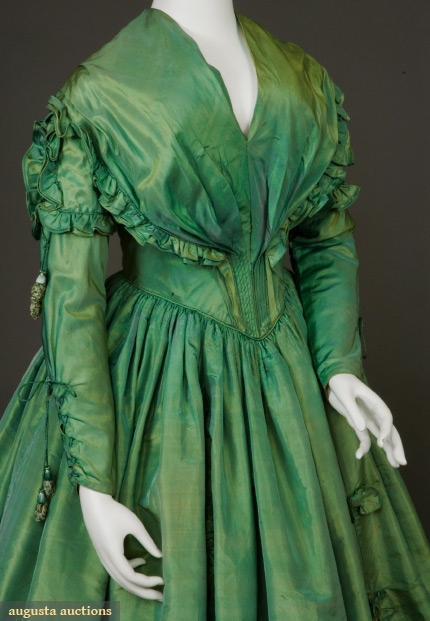

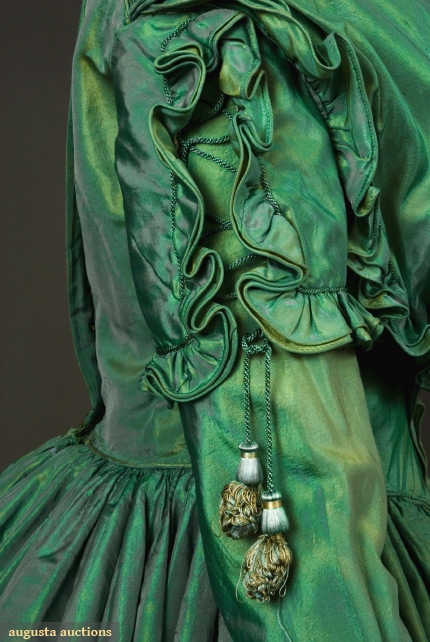
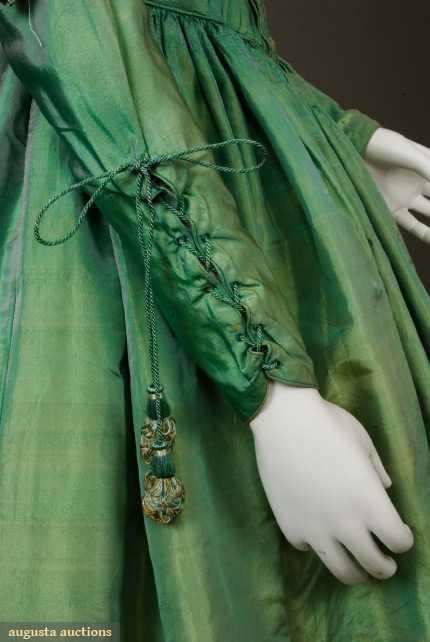
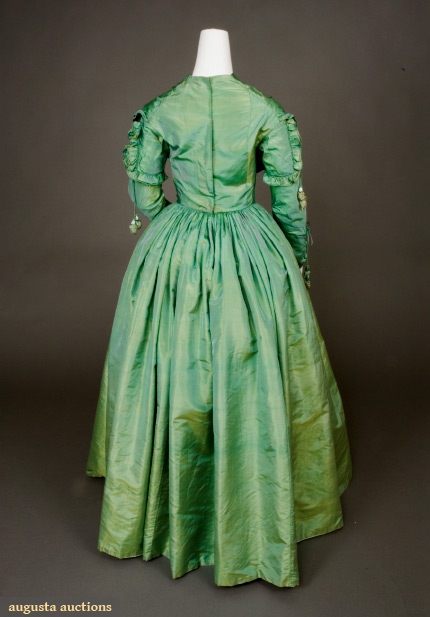
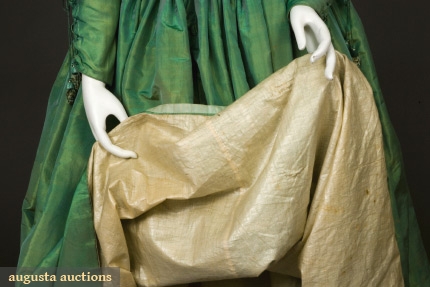
While this dress is all rather darling in its hues, it is nothing spectacular. The colour and the self trim stops it from being a creation of absolute boredom, only the one wouldn’t have been enough. It could however have used something more, perhaps a bit of contrasting trim picking up the gold tones of the main fabric. Tassels and I aren’t friends however, and the cords look like they are about to turn into a tangle-y mess, not bending where they should. If I didn’t have experience with the kind of cord I would have put that one down to age and not bothered with it, however, I’ve had the same problems with it as shiny new and so will have to deduce points for its inclusion.
7/10
Well. That is one of the colors that looks stunning on my daughter(makes all the green and gold in her eyes just pop). So 10 for color. I actually really like the dress too. Frou frou but time appropriate and not too over the top. I like the tassels too. So I’m going to go out on a limb and give it a 10 overall.
10.
The fabric is amazing, and I love the details, especially the center front bodice and those lovely little ruffles that wend up the bodice and around the sleeve vents. The lacing on the lower sleeves reminds me of Hollywood Maid Marion costumes, I’m sure there’s an historical period they actually echo but I’m full of thanksgiving dinner and can’t think. And I even like the tassels – they are handing from above the elbow, so you could actually function if you took a modicum of care. Is not a dress one would wear for doing housework anyway.
I’ve seen this dress before and always really liked it, but I’d never seen those close-up details. Ugh, I am not a fan of those tassels. Ignorance was bliss. 8/10
I feel the same way; they’re too much for me. Still, I’m very much biased in favour of 1840s fashions, and I’m also biased in favour od changeable green-gold (not a colour I can wear, but I do love it), so it’s an 8 from me.
(It reminds me of beetles wings. In a good way – those changeable ones I would admire as a child.)
https://hyperallergic.com/133571/fatal-victorian-fashion-and-the-allure-of-the-poison-garment/
Perhaps the most evocative fatal fashion trend of the 19th century is the color green. Before inventor Carl Wilhelm Scheele came along near the end of the 18th century, there was no color fast green, only the option to do a blue overlay with yellow or vice versa. By mixing arsenic and copper, Scheele developed a pigment that would hold, whether in wallpaper, paintings, or clothing. It also happened to look fantastic under natural and new gas light, an important duality for the time. By the mid-19th century, when, as Matthews David notes “nature was disappearing from the environment,” this “Emerald Green” was incredibly popular in artificial flowers. It was also highly toxic, even deadly, and it’s no coincidence that Baudelaire titled his book of tormented poems Les Fleurs du Mal – The Flowers of Evil – just as the death of a young artificial florist was being investigated.
I was thinking the same thing. I actually really like this dress but I am also worried that it caused the death of its wearer. That is potentially a LOT of arsenic in contact with sweating skin!
Also those mannequin hands holding the skirt up are charming and also terrifying.
Not all green 19th century garments were dyed with arsenic! That’s a huge misperception that keeps being perpetuated within the historical costuming community. I’ve worked in museums. I’ve seen test results for large collections of historical costumes where dozens of garments from 1800-1860 in similar shades that were instantly identified as ‘arsenic green’ were tested for arsenic, and the majority showed no trace of arsenic at all. Arsenic green has gotten a lot of publicity because it’s a ‘sexy/scary’ topic, and it is a really interesting historical footnote, but it wasn’t the only way to achieve green in-period. This dress may be arsenic green, but I’d lay better than even odds that it isn’t. And I live in hope that some historical fashion scholar will do a PHD exploring what percentage of extent garments that might have been dyed with arsenic green actually were, and how that relates to how prevalent arsenic green was within period!
Great! Thank you for that clarification. Do you know what other dyes would have been used for green?
Some of them! The really obvious one is the one they used for centuries before the invention of aniline green: overdyeing yellow fabric with indigo or woad. I’ll have to look up all the others.
Death by the dress. Vivid green color was often obtained by use of arsenic dyes. Apparently, there was a proverbial prejudice among seamstresses during 19th and 20th century against green, because of it. Artificial flowers workers had the worse of the arsenic poisoning damage, though (http://tinyurl.com/y7hum7sx).
I love everything about that dress, especially the vivid color, but it feels like a daring statment of “Fashion First !” If you’re ready to die for the dye, then rating it a 10 is a good famous last word.
9/10
Love it! Late 1830s into 40s is totally my jam though, so I’m biased…I love the overall toned-down trimmings with fussy meticulous details, often with gorgeous fabrics! I loooooove the poison-green shade of this silk. Only off note to me is the lacing on the lower sleeves; it looks “ye oldey medievally” in a clunky way.
(You should do a post on how not all 19thc green fabric is out to kill you… 😉 )
I love the design of this dress. The use of ruffles, the cut of the bodice. The heavy tassels on the sleeve laces are a bit silly, but the dress is so understated that the tassels do not offend me.
For once, my only qualms are about the color. Normally I love greens, but this iridescent green is offputting to me, like the color of a poisonous fish. However, I’m well-aware that changeable fabrics are hard to photograph well, and different monitors show colors with differing degrees of fidelity, so I won’t deduct much for the color.
9 out of 10.
I really like this dress! The only distraction is the tassels. I love the lacing and ruffles on the sleeves and I love the color. 9/10
It’s a nice dress, and the problem with “nice” is that I can’t find anything really bad about, but it doesn’t make me excited either. The tassels make me think about a certain other, film costume in green and with tassels though. My score is 8/10, as I said nothing but not exciting either.
I like it a lot. I love the colour (green is my favourite and I just don’t see enough of it.) I love the sleeves; the lacing is great and the little ruffles are so cute. Usually I’m not fond of tassels but I like these ones and they fit perfectly. I’m not fond of this style of bodice but I love the waist – the decoration and stitching is fantastic. Over all it’s just great
9/10
It reminds me of wilted fresh spinach, and I actually mean that in a good way! I think it is the prettiest colour and texture, and love the idea of a spinach dress!
This I find really lovely. I love texture, deep ruching, those structural flounces on the sleeves, yum!
10/10.
I quite like this one. The colour and style are pleasing to the eye. I guess the tassels are a bit jarring and my first thought was Miss Scarlett’s curtain dress in Gone with the Wind. Overall ok. I’m giving it 8/10.
Same thought re: Scarlett O’Hara!
I love the monochrome and details.
9/10
I love it! Because next to blue I adore green especially vibrant green like this. Was it al least out of the arsenic time range by then? And I also love small judiciously placed ruffles and I love silky cord and little acorns dangles and tassels! It is of its time. I think it is an excellent example of good taste for its purpose and era.
I love it! Because next to blue I adore green especially vibrant green like this. Was it al least out of the arsenic time range by then? And I also love small judiciously placed ruffles and I love silky cord and little acorns dangles and tassels! It is of its time. I think it is an excellent example of good taste for its purpose and era.
I actually really like the lacing, that’s such a good idea and it fits in with the whole ye olde timey references that were such a thing at the time. The colour is quite memorable, definitely a shade that demands to be called poison green even if not actually poisonous. A very striking dress and I love the detail work and even love the silly tassels even though I know full well they’re silly and impractical. 8.5/10
eleanorkeene.comYes….green dresses of this period often used Arsenic to help create this colour. I wrote an article on this about five years ago….
Garment can be found as the main image on my website….www.eleanorkeene.com
I think I have the article posted there too.
Have to say I haven’t updated my site for a while.
I arranged the sale of this dress at auction in Sydney….in features in Alison Matthews David’s book ‘Fashion Victims.’ And has been on rotation in an exhibition in Canada (With another similar dress) for the past couple of years…..that Alison was involved with.
Similar with dress in the discussion posted above, our green dress took on different appearances in the light & was hard to photograph.
I love the colour of the dicussion piece. The toggles on the sleeves are fun. I’m not a big fan of the decorative gathered layer on the bodice shoulder – come front.
What a beautiful dress! The colour, the cut, the fabric used, everything feels just right. As far as the period details are concerned, I am usually not very keen on tassels, but at that time they were quite fashionable and therefore belong to the dress.
9/10 and without the tassels I’d even go for 10/10.
This is one of my less favorite periods, but I really like this dress. I think it mostly comes down to that narrow V-neck, which gives the shoulders a bit of a stronger, more elegant look than others of this era. The sleeves are delightfully overfussed, though smaller, less dangly tassels would be an improvement (and a lot less frustrating for the wearer).
One thing I’m not sure of is the skirt shape. I like it as it looks here, but when worn properly, would it be more filled out with petticoats and hoops?
It’s not a jaw-dropper for me, but it’s balanced and gracious.
8.5
I find this dress overall quite pleasing. Because the trim is so complex, restricting it to the color/fabric of the dress itself keeps it from being distracting..
I really love the color(s), and would love to see how it would look in sunlight, daylight on a cloudy day or candlelight.
9 of 10
The colour is beautiful, and I love the (usually) restrained elegance of the 1840s – but I don’t love the sleeves on this dress: too much fussy detail for my personal taste. 8/10
I like the color and the sleeves embellishments. I’m kind of meh with the teasels, I think they’ll tangle with the minimal movement and that would become old really quickly. In any case, 9 out of 10 for this beauty.
I don’t know about this dress… I love the fabric and I think it would look amazing in real life but the dress is, like many 1840s day dresses, spectacularly ordinary. I mean the gathered/ piped trim adds interest and texture to the bodice, but also makes it look a bit frilly. And lettuce-y. Also, what with the lacing and the green fabric, it reminds slightly too much of Robin Hood, although that might be the photography because I think that in motion, when worn, it would look spectacular with the changeable green colour. Also, those tassels would have driven me insane if I had worn this, and I wouldn’t have lasted an hour before I took a pair of scissors to them.
So, despite the tassels and Sherwood Forest-ness and lettuce shaped trim, 8/10, because I still love the fabric.
I’m a big fan of the color of this dress, even though the green with the shoulder details kind of reminds me of a salad. Usually 1840s is a bit plain for me, but here I actually wish the upper part of the sleeve was a bit simpler.
I do love the lacing on the bottom of the sleeves. I wonder if the original wearer and I have similar tastes, because I am always tempted by unnecessary lacing on clothing. (although here it does seem to serve a purpose). I would have made the hanging tassels about half as long though, because they definitely look annoying.
8/10
The discussion of potential dye stuffs got me wondering if this dress is even green at all. That is, as a changeable silk, it could be woven from gold and blue threads that give the impression of green from a any distance, right? Either way, it’s a rather nice example of 1840’s style.
8/10
The more I look at this dress, the more I like it.
The colour is a bit too bright for me, but I like the details.
I’m not a fan of the shaping in the bust/shoulder area, but that could be due to the fact that the mannequin doesn’t have the right shape.
The only thing I would change/remove about the trimming is the lacing at the sleeves.
8/10
Love it. The colour (which would normally be slightly to yellow-toned for me, despite me loving green … but somehow here it really works). The 1840s shape (1830s and 40s has been growing on me a lot in the last few years). The tone-on-tone decoration, especially the interesting things going on in the upper sleeve.
I wish they’d laced the lower sleeves slightly differently, because they wouldn’t pucker half so bad (despite the manikin not filling them out quite enough) if they’d been laced more similarly to a corset.
But yes, interesting and lovely.
10/10
The shimmering green is lovely (and thanks to the comments section regarding arsenic dyes, or a lack thereof in some cases, I’ve a new set of things to go read up on, yay!) and the texture of the fabric looks nice. I’m not well-read on this decade by any means, but I do know I like this silhouette on this dress. The ruffles on the upper arm are a tad bit much for me though, and I’d probably want them toned down a bit, but the bodice ruffles and arm tassels are quite fun looking. 9/10 from me!
I’m sorry to say that the tassels, the ruffles and the precise shade of green all combined to make this dress look, to my eyes, EEEZACKLY like someone made a dress out of my grandfather’s sitting room curtains! With the tie-back cords providing the lacing, and the pelmet the trim 😀
Sad, but true. So I don’t think I’m appreciating this dress the way the rest of you can!
The silhouette is pretty. I think the tie-backs — I mean lacing! — would drive me crazy, dangling like that. And, er, would a fichu or something have been worn around the neck? The neckline looks a little bare, compared to the rest of the dress.
7/10, if I forgive the theft of my poor grandfather’s curtains!
All 1840’s dresses look the same to me, but I suppose fashion conservatism is natural in hard times, and they were the Hungry Forties. The silhouette is blah, but reassuring. I assume women would have varied their look with their linens, collars, and other accessories.
How many dresses would an average woman have owned at the time, I wonder? I’m thinkin of a scene in a movie version of The Mayor of Casterbridge where Lucetta is ordering a dress (or possibly fabric for a dress?) from a catalog and vaciliating between two colors, saying it’s a big decision what color you want to be for the next year. (She chooses red, an eye-catching color which later serves her ill when she is subject to a Skimmington Ride). She would have had more than one dress in total, but only one new one a year?
This one is not getting my love. Th only thing I like is the color, really.
2/10
Gorgeous, simply gorgeous. I have LOVED this shade of green all my life – still have a kindergarten finger-painted picture of a green and yellow fountain, whose colors I very deliberately chosen, since that combo was my favorite. Yellow lost its charm; green still has its.
The skirt would have fallen into a graceful bell shape, a little fuller than shown here. I suspect a filmy white fichu would have been worn tucked into the neckline, as otherwise this is a bit too deep-cut for a day dress. Might be okay for a dinner dress as is, however.
As for those pesky tassels – the lower one is shown tied in a bow. Enlarge the loops or tie a knot over them, and the tassels will be shortened.
The interesting modern provenance of the dress adds to its interest and value. Tasha Tudor had a fabulous collection of dresses and other items from this period, which she frequently featured in her (water color) illustrations. I wonder if she ever illustrated this particular dress??
10/10. No question, it’s a 10 all around for me!
I used to do a lot of of natural dying using wool & also embroidery silks which I used to sell. So you can say I’m experienced. to get a green you can use a yellow from numerous plants as this this is the most common result & a blue from woad or indigo. Woad & indigo contain the same chemical. The dye would have to be fixed to the yarn /fabric with a mordant ( from the French word Morde meaning to bite ) this could have been one of many minerals or chemicals. The least toxic being alum & also commonly used was copper sulphate. Different shade were obtained by using different proportions of the 2 colours & the kind of silk / wool which the yarn or fabric was made of. My guess is that the silk for this dress is naturally dyed although chemicals could have been used.
Forgot to rate the dress! An unremarkable dress but I wonder if a redheaded women wore it when it would have looked wonderful. Because the colour is lovely & hopefully not poisonous. 8/10
I love the color.
I like the lacing.
The ruffles are just kinda eh.
I can’t be grumpy at a historical silhouette for not suiting my modern sensibilities, although this droopy shoulder look invariably makes me feel depressed.
So – 8/10
I’m gonna give it an 8.5.
It loses 1/2 point because I’d like some of the trim to be in a contrasting color, maybe gold?
Then another point because those tassels seem horrid and too clunky.
I love the beautiful changable silk there’s just too much of it. And the silk is the only thing I like about the dress.
The bodice looks clumsy. There’s some fine stitching on the front of the bodice, but it can’t be seen with all the green. The bulky double ruffling camouflages the stiching even more. Ugly double ruffling everywhere, and those sleeves! Lacing, toggles?
The poor woman. I feel sorry for her. To think that she wore this in public.
2 out of 10 because the silk is gorgeous.
I love this dress, in part because I choose to believe that the designer had a quirky sense of humour, and was making an intentional nod towards leafy greens!
The colour is unusual and beautiful (and would look stunning on the right person), and I find the overall design and decoration really pleasing to the eye. Though I agree that the tassels would benefit from being about half the length they are.
The fit around the shoulder line and back is a little awkward, but I’m presuming that’s a problem with the display mannequin and not a result of poor fitting/design.
Overall, I’m completely charmed by this dress. I think it’s clever and beautiful, and it gives me a strong sense that its wearer would have made great company! The only thing that keeps me from giving it a top score are the little brussels sprout rosettes running down the skirt. In theory I find them cute, but I think a plain and undecorated skirt would help keep the witty design statement of the gowns top half succinct. Pluck them off and add them to a straw bonnet, or some little matching silk slippers instead.
It’s a 9.5/10 from me!